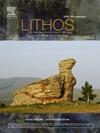Age and geology of granitoids in northeast Palmer Land, Antarctic Peninsula
IF 2.5
2区 地球科学
Q2 GEOCHEMISTRY & GEOPHYSICS
引用次数: 0
Abstract
The Antarctic Peninsula preserves a long history of Late Paleozoic and Mesozoic magmatism that reflects dynamic processes along the southwestern Gondwanan convergent margin. Granitoid magmatism is widespread across the Peninsula and records a complex history of subduction, massive silicic volcanism, and metamorphism. However, direct field observations are rare due to the inaccessibility of many remote outcrops, particularly in the central sector of the Antarctic Peninsula. Robust petrochronological data are even more scarce, limiting the ability to connect rock exposures across large ice-covered areas. Plutonic rocks across parts of the southern Antarctic Peninsula (northeast Palmer Land) lack detailed characterisation and geochronological constraints. Here, U![]() Pb isotopes and trace elements (e.g., Ti, P, Ce, Eu, and other REEs) are analysed in zircon (n = 1148) from archived samples from Mount Faith, Mount Sullivan, and Engel Peaks to calculate the timing and nature of magmatic and metamorphic events. These data are supplemented with in situ and whole-rock geochemistry. The resulting magmatic crystallisation ages are Early Jurassic (188–179 Ma) for calc-alkaline, peraluminous, weakly S-type granitoids at all three locations. This novel age constraint for the Mount Faith Granite: (1) indicates it is distinct from all three granitoid emplacement phases at Mount Charity immediately south, and (2) provides an upper age limit on cross-cutting tholeiitic mafic dykes. Deformation of the Mount Faith Granite could reflect either post-crystallisation strain or syn-emplacement strain that deformed granitoids of the Subcordilleran Plutonic Belt. Early Cretaceous (116–120 Ma) recrystallisation of Early Jurassic zircon provide evidence of the first phases of the Palmer Land Event on the central Peninsula. New data presented here provide a detailed geochronology of granitoids in northeast Palmer Land that can be used for Mesozoic tectonic reconstructions.
Pb isotopes and trace elements (e.g., Ti, P, Ce, Eu, and other REEs) are analysed in zircon (n = 1148) from archived samples from Mount Faith, Mount Sullivan, and Engel Peaks to calculate the timing and nature of magmatic and metamorphic events. These data are supplemented with in situ and whole-rock geochemistry. The resulting magmatic crystallisation ages are Early Jurassic (188–179 Ma) for calc-alkaline, peraluminous, weakly S-type granitoids at all three locations. This novel age constraint for the Mount Faith Granite: (1) indicates it is distinct from all three granitoid emplacement phases at Mount Charity immediately south, and (2) provides an upper age limit on cross-cutting tholeiitic mafic dykes. Deformation of the Mount Faith Granite could reflect either post-crystallisation strain or syn-emplacement strain that deformed granitoids of the Subcordilleran Plutonic Belt. Early Cretaceous (116–120 Ma) recrystallisation of Early Jurassic zircon provide evidence of the first phases of the Palmer Land Event on the central Peninsula. New data presented here provide a detailed geochronology of granitoids in northeast Palmer Land that can be used for Mesozoic tectonic reconstructions.
南极半岛帕尔默地东北部花岗岩的时代和地质特征
南极半岛保存了悠久的晚古生代和中生代岩浆活动历史,反映了冈瓦南西南辐合边缘的动力学过程。花岗岩类岩浆活动在整个半岛广泛存在,并记录了一个复杂的俯冲、大规模硅质火山活动和变质作用的历史。然而,由于许多偏远的露头难以接近,特别是在南极半岛的中部地区,直接的实地观测很少。可靠的岩石年代学数据更加稀缺,限制了将大面积冰雪覆盖地区的岩石暴露联系起来的能力。南极半岛南部部分地区(帕尔默地东北部)的深成岩缺乏详细的特征和年代学限制。在这里,UPb同位素和微量元素(例如,Ti, P, Ce, Eu和其他稀土元素)分析了来自Faith山,Sullivan山和Engel峰的存档样本的锆石(n = 1148),以计算岩浆和变质事件的时间和性质。这些数据补充了原位和全岩地球化学数据。所得岩浆结晶年龄均为早侏罗世(188-179 Ma),为钙碱性、过铝质、弱s型花岗岩。这种新的年龄限制:(1)表明它与紧靠南面的Charity山的所有三个花岗岩侵位阶段都不同;(2)提供了交叉的拉斑岩基性岩脉的年龄上限。费斯山花岗岩的变形可以反映下科迪勒岩带花岗岩类变形的后结晶应变或同侵位应变。早白垩世(116-120 Ma)早侏罗世锆石的再结晶为中部半岛的帕尔默陆地事件的第一阶段提供了证据。新资料提供了帕尔默地东北部花岗岩类的详细年代学,可用于中生代构造重建。
本文章由计算机程序翻译,如有差异,请以英文原文为准。
求助全文
约1分钟内获得全文
求助全文
来源期刊

Lithos
地学-地球化学与地球物理
CiteScore
6.80
自引率
11.40%
发文量
286
审稿时长
3.5 months
期刊介绍:
Lithos publishes original research papers on the petrology, geochemistry and petrogenesis of igneous and metamorphic rocks. Papers on mineralogy/mineral physics related to petrology and petrogenetic problems are also welcomed.
 求助内容:
求助内容: 应助结果提醒方式:
应助结果提醒方式:


